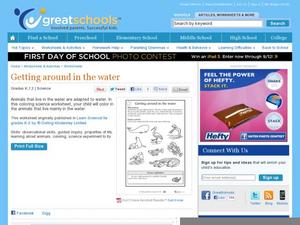Nemours KidsHealth
Food Allergies: Grades 6-8
Over two lessons, scholars use articles and discussions to define what a food allergy is and identify the most common food allergens. Small groups prepare a skit showcasing how the body exhibits an allergic reaction. Learners examine...
Howard Hughes Medical Institute
Sorting Seashells
Scientists use morphological, physiological, and molecular information to continually revise organism classification. Scholars observe and learn about 20 shells. Then, they work to sort and classify the shells, building a taxonomy based...
Curated OER
Getting Around in the Water
Young scientists who are learning about the variety of environments that animals live in use a activity in order to choose animals that live, primarily, in water environments. There are eight pictures on the activity, and learners must...
Curated OER
Marine Fisheries Management
Almost 200 slides make this a vast collection! It is a quirky collection, titled "Marine Fisheries Management," but having little to do with that occupation. What you will find are two-toned blue backgrounds with no pictures, but a few...
Curated OER
Something's Fishy. . . Classes and Qualities of Fish and Seafood
If you are going to eat seafood, it helps to understand the different classifications. In this presentation, viewers learn to differentiate two types of finfish and the variations of edible shellfish. They also examine the...
Curated OER
Net Results
Students investigate through role play how decisions by watermen, recreational fisherpeople, and lawmakers influence and are influenced by economics and the abundance or scarcity of fish and shellfish stocks. They consider social,...
Curated OER
Clam Hooping
Students explore ocean biology by capturing organisms on a beach. In this clam collecting lesson, students identify the clam species and discuss the anatomy of a clam as well as the importance they provide as a meal. Students utilize a...
Curated OER
Crawdad Grab
Learners explore biology by conducting a freshwater fishing activity. In this crawdad lesson, students discuss what a crawdad is, where they are found and how they can be prepared as a meal. Learners utilize string, alligator clips,...
Curated OER
Shellfish Shenanigans
Twelfth graders create simulations of a reality-based TV show that investigates the near death of a contestant from a seafood meal. They examine the physical symptoms of anaphylactic shock, and create protein fingerprints.
Other
North Carolina Dept of Environment & Natural Resources: Cool Kids: Shellfish
Find information on shellfish rehabilitation and other bivalves like clams, oysters, and scallops. One of the most interesting pages is the stock status that indicates how fish populations are surviving in fisheries in North Carolina.
NOAA
Noaa: Northeast Fisheries Science Center: Fish Faq
This site is provided for by the Northeast Fisheries Science Center. Do fish sleep? Do they chew food? Can any fish swim backwards? How many Pinnipeds are on the Endangered Species List? Find out the answers to these questions and many...
Other
Blue Crabs
Site provides helpful information on the blue crab. Users will discover interesting facts as they peruse this brief but informative site.
PBS
Newton's Apple: Black Pearls
A lab activity to illicit discussion/understanding of the way in which mollusks produce an economic product.
Unique Australian Animals
Unique Australian Animals: Yabby
The Yabby is an Australian freshwater crayfish. Read the description at this website to learn more.














